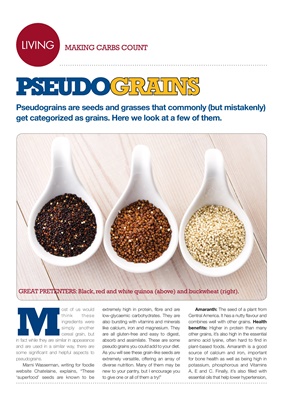
LIVINGLIVING
Pseudograins are seeds and grasses that commonly (but mistakenly)
get categorized as grains. Here we look at a few of them.
PSEUDOGRAINS
MAKING CARBS COUNT
Most of us would
think these
ingredients were
simply another
cereal grain, but
in fact while they are similar in appearance
and are used in a similar way, there are
some significant and helpful aspects to
pseudograins.
Marni Wasserman, writing for foodie
website Chatelaine, explains, "These
'superfood' seeds are known to be
extremely high in protein, fibre and are
low-glycaemic carbohydrates. They are
also bursting with vitamins and minerals
like calcium, iron and magnesium. They
are all gluten-free and easy to digest,
absorb and assimilate. These are some
pseudo grains you could add to your diet.
As you will see these grain-like seeds are
extremely versatile, offering an array of
diverse nutrition. Many of them may be
new to your pantry, but I encourage you
to give one or all of them a try!"
Amaranth: The seed of a plant from
Central America. It has a nutty flavour and
combines well with other grains. Health
benefits: Higher in protein than many
other grains, it's also high in the essential
amino acid lysine, often hard to find in
plant-based foods. Amaranth is a good
source of calcium and iron, important
for bone health as well as being high in
potassium, phosphorous and Vitamins
A, E and C. Finally, it's also filled with
essential oils that help lower hypertension,